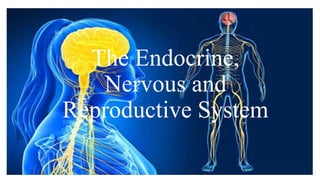The Endocrine, Nervous and Reproductive System.pptx
- 1. The Endocrine, Nervous and Reproductive System
- 2. Homeostasis and Feedback Mechanisms ’ü▒ Homeostasis ’ā╝ the balance state of internal conditions despite changes in external environment ’ā╝ different body systems complement one another to create internal balance- homeostatic regulation
- 3. Homeostasis and Feedback Mechanisms ’ü▒ Endocrine Glands ŌĆō secrete hormones that help regulate the activities of cells ’ü▒ Stimulus- any external or internal change in the environment ’ü▒ External Stimulus- arises from outside the body ’ü▒ Internal Stimulus- originates within the body ’ü▒ Feedback mechanism/ feedback regulation- self- adjusting mechanism
- 4. 2 Types of Feedback Mechanism 1. Negative feedback loop - response reduces the stimulus until conditions return to a homeostatic state.
- 6. 2 Types of Feedback Mechanism 2. Positive feedback loop - occurs when a response amplifies a stimulus, which in turn elicits further response.
- 8. Homeostasis and Feedback Mechanisms ’ü▒ Neuroendocrine System- endocrine + nervous system ’ü▒ Hypothalamus- contains neurosecretory cells, sends hormones.
- 9. Target cells ŌĆó Blood facilitates the circulation of hormones. ŌĆó Hormones are recognized by their target cells via membrane receptors ŌĆó Molecular shape of the hormone should physically fit the target cellŌĆÖs receptor so that the hormone receptor complex can initiate the response.
- 11. The Endocrine System ’ü▒ chemical messengers (hormones) ’ü▒ 2 types of glands ’ā╝ Endocrine glands - Release their hormones directly into the bloodstream ’ā╝ Exocrine glands - Release their secretion through ducts
- 13. Pituitary Gland and Hypothalamus ’ü▒ Produce hormones and controls various glands ’ü▒ close to the hypothalamus and is connected to the blood vessels and nerves ’ü▒ ŌĆ£Master GlandŌĆØ ’ü▒ Composed of the anterior and posterior lobe ’ü▒ Posterior lobe ’āś extension of the hypothalamus ’āś antidiuretic hormone (ADH) & Oxytocin
- 15. Pituitary Gland and Hypothalamus ’ü▒ Antidiuretic hormone (ADH) ’āś decreases the amount of urine exerted by the kidneys ’ü▒ Oxytocin ’āś promote ŌĆ£milk letdownŌĆØ
- 16. Pituitary Gland and Hypothalamus ’ü▒ Anterior lobe ’āś Secretes rolactin, gonadotropic hormones, thyroid- stimulating hormone (TSH) and growth hormones.
- 17. Thyroid Gland ’ü▒ located at the base of the neck ’ü▒ thyroxine is converted into triiodothyronine, the active form of thyroid hormone ’ü▒ Calcitonin- lowers calcium levels ’ü▒ Hypothyroidism- underactive thyroid gland, decreases metabolic rate - radioactive iodine treatment
- 19. Thyroid Gland ’ü▒ Cretinism- physical and mental retardation ’ü▒ Goiter- abnormal enlargement of the thyroid gland ’ü▒ Levothyroxine- a thyroid hormone
- 20. Parathyroid Gland ’ü▒ at the back of the thyroid gland ’ü▒ Parathormones ’ā╝regulate calcium in the blood and oppose the action of calcitonin ’ā╝Enhance calcium absorption ’ā╝Calcium ( muscle contraction, blood clotting and others)
- 21. Adrenal Gland ’ü▒ above the kidney ’ü▒ inner part (adrenal medulla) ’ü▒ outer part (adrenal cortex)
- 22. Adrenal Medulla ŌĆó epinephrine ( adrenaline) and norepinephrine (norepinephrine) ŌĆó helps the body to respond to emergencies. ŌĆó Adrenaline ŌĆō ŌĆ£emergency hormonesŌĆØ
- 23. Adrenal Cortex ŌĆó glucocorticoids, mineralocorticoids and sex hormones ŌĆóFirst two, prolonged stress and mobilizing energy reserves. ŌĆó Cortisol- helps body respond to stress. ŌĆó Aldosterone- regulates salt and water in the body.
- 24. Pancreas ŌĆó located between the spleen and small intestine. ŌĆó produces digestive enzymes and hormones ŌĆó Islets of Langerhans- produce pancreatic amylase ŌĆó secrete insulin, glucagon and somatostatin ŌĆó Insulin- lowers blood sugar level ŌĆó Glucagon ŌĆōrises blood sugar level ŌĆó Somatostatin- inhibits secretion of other hormones
























